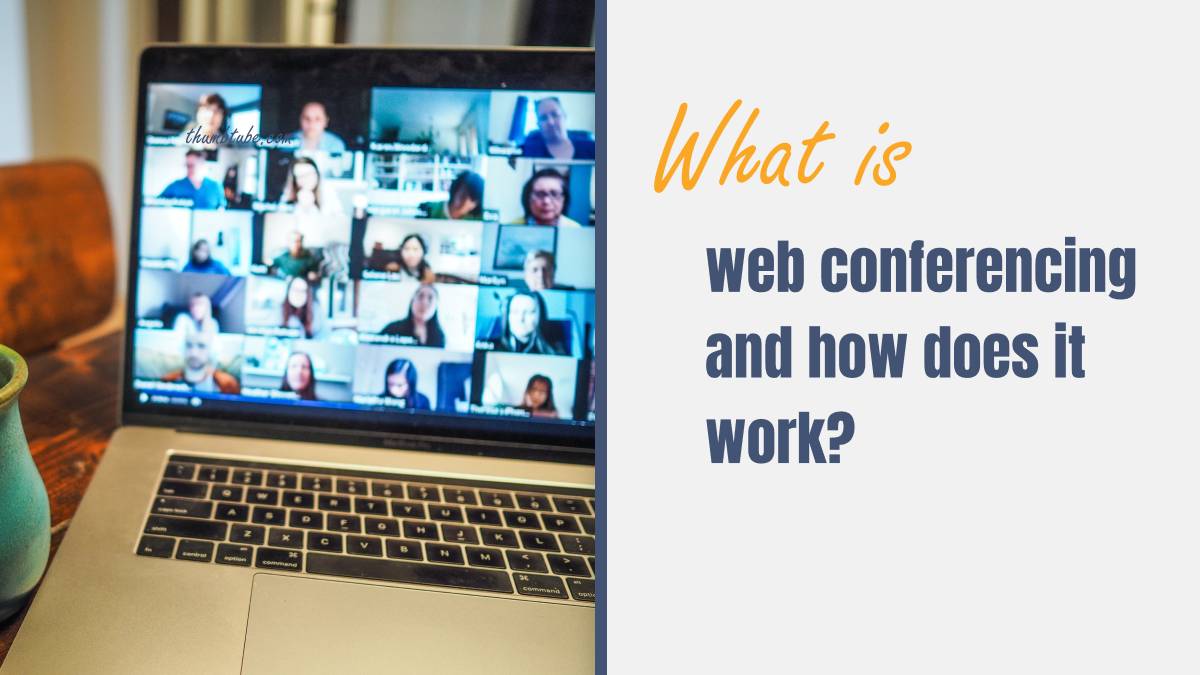In a world where technology has become an essential part of our lives, web conferencing has emerged as a revolutionary tool for communication and collaboration. Whether it be for business meetings, educational seminars, or social gatherings, web conferencing has transformed the way we connect with others across distances. But what exactly is web conferencing and how does it work? In this article, we will delve into the intricacies of this powerful communication medium, exploring its definition, features, and the underlying technology that enables seamless virtual interactions. So grab your devices and get ready to embark on an enlightening journey through the realm of web conferencing!
What is web conferencing?
Web conferencing has become an essential tool for businesses and individuals alike, especially in today’s digital age. Simply put, web conferencing is a technology that allows users to hold virtual meetings or discussions over the internet. It enables participants from different locations to connect and collaborate without the need for physical presence.
One of the key advantages of web conferencing is its versatility. It not only supports audio and video communication but also provides features like screen sharing, file sharing, chat messaging, and whiteboarding. This enhances collaboration by allowing participants to share documents, presentations, or other relevant materials in real-time during the meeting. Moreover, web conferencing platforms often offer recording options, enabling users to capture important discussions or presentations for future reference.
The flexibility offered by web conferencing makes it suitable for various scenarios: team meetings, sales presentations, client meetings, training sessions, or even large-scale webinars with hundreds of attendees. With just a stable internet connection and compatible devices like computers or smartphones equipped with a microphone and camera setup — users can join these virtual conferences effortlessly from anywhere at any time.
In conclusion, web conferencing has significantly transformed the way people communicate and collaborate remotely. This versatile technology has made it possible to bridge distances between colleagues and clients effectively while saving valuable time and resources related to travel. The rise of web conferencing indicates not just a change in how business meetings are conducted; it represents a paradigm shift towards more flexible work arrangements where physical proximity is no longer an obligatory factor in effective collaboration.

Definition and Purpose
Web conferencing is a powerful tool that allows individuals or groups to communicate and collaborate in real-time over the internet. It enables participants from different locations to connect through audio, video, and chat functions, creating a virtual meeting space that mimics face-to-face interactions. But beyond its basic definition lies a unique purpose that sets web conferencing apart from other communication platforms.
The primary purpose of web conferencing is to enhance productivity and efficiency within organizations by reducing the need for physical meetings and travel. In today’s fast-paced business landscape, time is of the essence, and web conferencing provides a convenient solution for teams spread across various locations. This technology eliminates geographical barriers, connecting remote workers seamlessly in one virtual room where they can share information, ideas, documents, and screens instantly. With features like screen sharing and collaborative document editing, web conferencing empowers teams to work together on projects without being physically present in the same room.
Additionally, web conferencing also fosters improved communication among individuals who cannot meet face-to-face due to time constraints or logistical issues. Whether it is connecting with clients or conducting training sessions for employees stationed in different regions, this technology helps bridge gaps by providing an interactive platform where ideas can be shared efficiently. By breaking down physical boundaries imposed by traditional meetings or phone calls alone, web conferencing enhances collaboration among diverse groups of people with unique perspectives and expertise.
Key Features of Web Conferencing
One of the key features of web conferencing is the ability to host virtual meetings with participants from anywhere in the world. In today’s globalized business environment, this feature has become essential for companies that have teams and clients spread across different locations. With web conferencing, participants can join a virtual meeting room using just their laptops or mobile devices, eliminating the need for travel and saving both time and money.
Another important feature of web conferencing is screen sharing. This allows presenters to share their computer screens with others in real-time, making it easy to collaborate on projects, give presentations, or provide training. Screen sharing also enables participants to see exactly what is being discussed or demonstrated, ensuring that everyone is on the same page. Furthermore, some web conferencing platforms even offer advanced features like annotation tools and remote control capabilities, giving users greater control over their shared screens.
Lastly, many web conferencing solutions come with recording options. This means that even if someone misses a meeting or presentation, they can easily access a recording later on. Recording web conferences not only ensures that no important information is lost but also allows for follow-up sessions where participants can review previous discussions. Having this feature adds convenience for busy professionals who may need to revisit certain points at their own pace or refer back to recorded conversations as needed.

How Does Web Conferencing Work?
Web conferencing has revolutionized the way we communicate and collaborate in the modern era. But have you ever wondered how it actually works? Let’s dive into the intricacies of web conferencing to understand its inner workings.
At its core, web conferencing is a technology that allows people to hold meetings, presentations, or discussions remotely using their computers or mobile devices. The process starts with a host who initiates the conference by sending out unique meeting links or invitations to participants. These links typically contain all the necessary information for attendees to join, including log-in credentials and meeting details. Once connected, participants can interact through various features like video streaming, chat boxes, screen sharing, and file transfer options.
Behind the scenes, web conferencing relies heavily on robust server infrastructure and sophisticated audio and video codecs. These codecs compress audio-visual data into packets that are transmitted over the internet in real-time. Additionally, secure protocols such as Transport Layer Security (TLS) encrypt these data packets to ensure privacy and prevent unauthorized access. Overall, web conferencing combines software solutions with reliable internet connectivity to create a seamless virtual meeting experience for users worldwide.
In conclusion, web conferencing has become an essential tool for businesses and individuals alike due to its convenience and flexibility. By understanding how this technology works from both a technical and user perspective, we gain an appreciation for its power in connecting people across time zones and geographical boundaries seamlessly.
Benefits of Web Conferencing
Web conferencing has become an essential tool in the modern business landscape, offering numerous benefits that can enhance collaboration and productivity. Firstly, web conferencing eliminates the need for travel, saving both time and money. With a stable internet connection, participants can join meetings from anywhere in the world, reducing the logistical challenges associated with face-to-face meetings. This allows businesses to connect with clients and colleagues across different time zones without difficulty.
Secondly, web conferencing facilitates real-time communication through chat features and instant messaging. Participants can share documents, presentations, or screens seamlessly during a meeting, ensuring everyone is on the same page and making it easier to collaborate effectively. Moreover, web conferencing often includes recording capabilities that enable participants to revisit important discussions or refer back to specific points of interest later on.
Another advantage of web conferencing is its ability to foster inclusivity. People with physical disabilities or those unable to attend in-person events due to personal circumstances can still actively participate virtually through web conferencing platforms. Additionally, language barriers can be overcome by utilizing translation features available in some programs. By including more individuals in meetings and discussions regardless of their location or circumstances, businesses promote diversity while leveraging a wider range of perspectives.
In conclusion, web conferencing streamlines collaboration by eliminating travel limitations while offering real-time communication capabilities alongside enhanced inclusivity. Businesses that leverage these benefits can save costs on travel expenses while increasing efficiency by connecting people from around the world quickly and conveniently.

Popular Web Conferencing Platforms
When it comes to web conferencing platforms, there are a few that stand out as the most popular and widely used in today’s digital world. Zoom, for instance, has become a household name during the COVID-19 pandemic due to its user-friendly interface and reliable performance. Apart from being easy to set up and use, Zoom offers various features such as the ability to record meetings, share screens and files, and host large webinars with hundreds of participants.
Another popular platform is Microsoft Teams. While initially designed for workplace collaboration and communication, Microsoft Teams has quickly gained traction in the web conferencing space. It integrates seamlessly with other Office 365 applications and allows users to create virtual meeting rooms where they can chat, make audio or video calls, share documents in real time during meetings, all while providing robust security options.
Google Meet is also worth mentioning as it caters to individuals and businesses alike. Formerly known as Hangouts Meet, this platform offers simplified video conferencing capabilities right within the Google ecosystem. With features like real-time captions and live streaming options for larger audiences, Google Meet is a reliable choice for remote team collaborations or even personal catch-up sessions with friends or family.
The competition among these popular web conferencing platforms is fierce as each continuously strives to improve its offerings with new updates and features based on user feedback. Tapping into one of these platforms means gaining access not only to video conferences but also to seamless document collaboration tools–helping us stay connected beyond geographical boundaries.
Conclusion: The Future of Web Conferencing
As we delve into the world of web conferencing in this article, it is clear that this technology has transformed the way businesses and individuals communicate remotely. But what does the future hold for web conferencing? Undoubtedly, advancements in artificial intelligence (AI) will play a significant role. AI-powered virtual assistants can already transcribe meetings, schedule appointments, and even provide real-time translation services. In the coming years, we can expect to see more sophisticated AI capabilities integrated with web conferencing tools to enhance collaboration and streamline communication.
Furthermore, as internet speeds continue to improve globally, we can anticipate a rise in 3D video streaming during web conferences. This immersive experience will allow participants to feel like they are sitting across from one another in a physical meeting room. Additionally, with virtual reality (VR) gaining momentum in various industries, it is not far-fetched to consider VR integration within web conferencing platforms for an even more interactive and engaging experience.
Lastly, as sustainability becomes an increasingly important concern for individuals and organizations alike, eco-friendly features may also become a prominent aspect of future web conferencing solutions. Technologies that reduce bandwidth usage or optimize energy consumption during video calls could help minimize the environmental impact associated with remote meetings.
